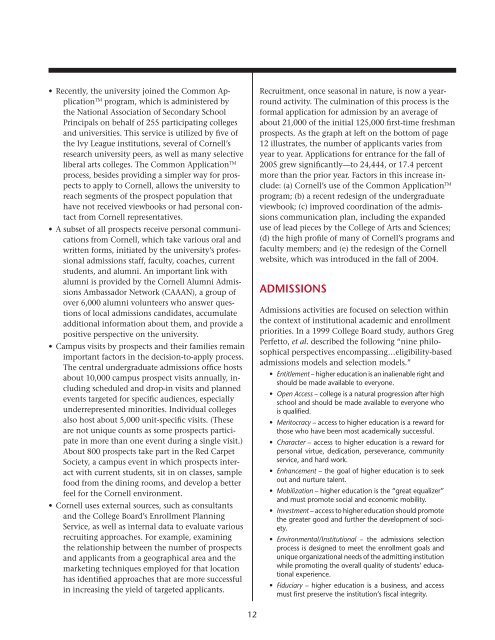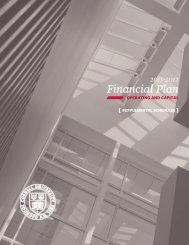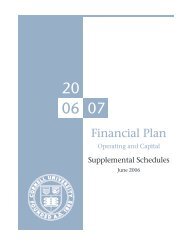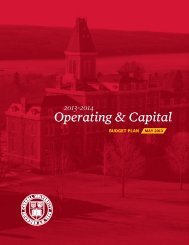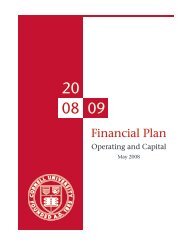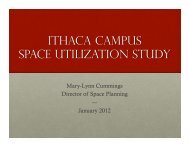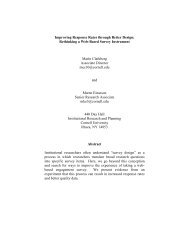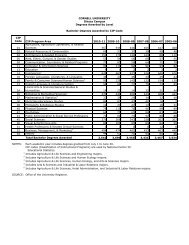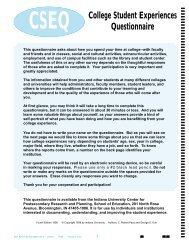Undergraduate Student Access - Cornell University Division of ...
Undergraduate Student Access - Cornell University Division of ...
Undergraduate Student Access - Cornell University Division of ...
Create successful ePaper yourself
Turn your PDF publications into a flip-book with our unique Google optimized e-Paper software.
• Recently, the university joined the Common ApplicationTM program, which is administered bythe National Association <strong>of</strong> Secondary SchoolPrincipals on behalf <strong>of</strong> 255 participating collegesand universities. This service is utilized by five <strong>of</strong>the Ivy League institutions, several <strong>of</strong> <strong>Cornell</strong>’sresearch university peers, as well as many selectiveliberal arts colleges. The Common Application TMprocess, besides providing a simpler way for prospectsto apply to <strong>Cornell</strong>, allows the university toreach segments <strong>of</strong> the prospect population thathave not received viewbooks or had personal contactfrom <strong>Cornell</strong> representatives.• A subset <strong>of</strong> all prospects receive personal communicationsfrom <strong>Cornell</strong>, which take various oral andwritten forms, initiated by the university’s pr<strong>of</strong>essionaladmissions staff, faculty, coaches, currentstudents, and alumni. An important link withalumni is provided by the <strong>Cornell</strong> Alumni AdmissionsAmbassador Network (CAAAN), a group <strong>of</strong>over 6,000 alumni volunteers who answer questions<strong>of</strong> local admissions candidates, accumulateadditional information about them, and provide apositive perspective on the university.• Campus visits by prospects and their families remainimportant factors in the decision-to-apply process.The central undergraduate admissions <strong>of</strong>fice hostsabout 10,000 campus prospect visits annually, includingscheduled and drop-in visits and plannedevents targeted for specific audiences, especiallyunderrepresented minorities. Individual collegesalso host about 5,000 unit-specific visits. (Theseare not unique counts as some prospects participatein more than one event during a single visit.)About 800 prospects take part in the Red CarpetSociety, a campus event in which prospects interactwith current students, sit in on classes, samplefood from the dining rooms, and develop a betterfeel for the <strong>Cornell</strong> environment.• <strong>Cornell</strong> uses external sources, such as consultantsand the College Board’s Enrollment PlanningService, as well as internal data to evaluate variousrecruiting approaches. For example, examiningthe relationship between the number <strong>of</strong> prospectsand applicants from a geographical area and themarketing techniques employed for that locationhas identified approaches that are more successfulin increasing the yield <strong>of</strong> targeted applicants.Recruitment, once seasonal in nature, is now a yearroundactivity. The culmination <strong>of</strong> this process is theformal application for admission by an average <strong>of</strong>about 21,000 <strong>of</strong> the initial 125,000 first-time freshmanprospects. As the graph at left on the bottom <strong>of</strong> page12 illustrates, the number <strong>of</strong> applicants varies fromyear to year. Applications for entrance for the fall <strong>of</strong>2005 grew significantly—to 24,444, or 17.4 percentmore than the prior year. Factors in this increase include:(a) <strong>Cornell</strong>’s use <strong>of</strong> the Common Application TMprogram; (b) a recent redesign <strong>of</strong> the undergraduateviewbook; (c) improved coordination <strong>of</strong> the admissionscommunication plan, including the expandeduse <strong>of</strong> lead pieces by the College <strong>of</strong> Arts and Sciences;(d) the high pr<strong>of</strong>ile <strong>of</strong> many <strong>of</strong> <strong>Cornell</strong>’s programs andfaculty members; and (e) the redesign <strong>of</strong> the <strong>Cornell</strong>website, which was introduced in the fall <strong>of</strong> 2004.ADMISSIONSAdmissions activities are focused on selection withinthe context <strong>of</strong> institutional academic and enrollmentpriorities. In a 1999 College Board study, authors GregPerfetto, et al. described the following “nine philosophicalperspectives encompassing…eligibility-basedadmissions models and selection models.”• Entitlement – higher education is an inalienable right andshould be made available to everyone.• Open <strong>Access</strong> – college is a natural progression after highschool and should be made available to everyone whois qualified.• Meritocracy – access to higher education is a reward forthose who have been most academically successful.• Character – access to higher education is a reward forpersonal virtue, dedication, perseverance, communityservice, and hard work.• Enhancement – the goal <strong>of</strong> higher education is to seekout and nurture talent.• Mobilization – higher education is the “great equalizer”and must promote social and economic mobility.• Investment – access to higher education should promotethe greater good and further the development <strong>of</strong> society.• Environmental/Institutional – the admissions selectionprocess is designed to meet the enrollment goals andunique organizational needs <strong>of</strong> the admitting institutionwhile promoting the overall quality <strong>of</strong> students’ educationalexperience.• Fiduciary – higher education is a business, and accessmust first preserve the institution’s fiscal integrity.12


